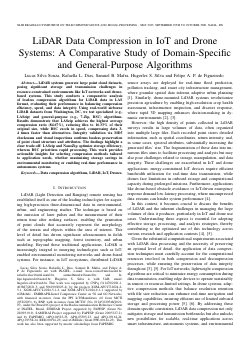
LiDAR Data Compression in IoT and Drone Systems: A Comparative Study of Domain-Specific and General-Purpose Algorithms
Lucas Silva Souza, Rafaella Laureano Dias, Samuel Mafra, Hugerles S. Silva, Felipe Augusto Pereira de Figueiredo
DOI: 10.14209/sbrt.2025.1571155487
Evento: XLIII Simpósio Brasileiro de Telecomunicações e Processamento de Sinais (SBrT2025)
Keywords: data compression LiDAR IoT Drone
Abstract
LiDAR systems generate large point cloud datasets, posing significant storage and transmission challenges in resource-constrained environments like IoT networks and drone-based systems. This study conducts a comparative analysis of lossless compression algorithms for LiDAR data in LAS format, evaluating their performance in balancing compression efficiency, speed, and data integrity. Using real-world airborne LiDAR datasets from Washington, DC, we test specialized (e.g., LASzip) and general-purpose (e.g., 7-Zip, BSC) algorithms. Results demonstrate that LASzip achieves the highest average compression ratio (84.67\%), reducing files to 16.33\% of their original size, while BSC excels in speed, compressing data 3-4 times faster than alternatives. Integrity validation via MD5 checksums and visual inspections confirms lossless preservation of point cloud structure and attributes. The findings highlight a clear trade-off: LASzip and NanoZip optimize storage efficiency, whereas BSC prioritizes rapid processing. This work provides actionable insights for selecting compression methods tailored to application needs, whether maximizing storage savings in environmental monitoring or enabling real-time performance in autonomous systems.Download